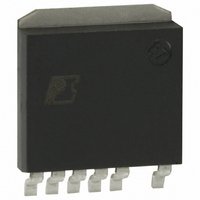DPA426SN Power Integrations, DPA426SN Datasheet - Page 5

DPA426SN
Manufacturer Part Number
DPA426SN
Description
IC CONV DC-DC DPA SWITCH SPAK
Manufacturer
Power Integrations
Series
DPA-Switch®r
Specifications of DPA426SN
Applications
Converter, Power Over Ethernet and Telecom Applications
Voltage - Input
16 ~ 75 V
Number Of Outputs
1
Voltage - Output
220V
Operating Temperature
-40°C ~ 125°C
Mounting Type
Surface Mount
Package / Case
SPak (5 leads + Tab)
Mounting Style
SMD/SMT
Lead Free Status / RoHS Status
Lead free / RoHS Compliant
Available stocks
Company
Part Number
Manufacturer
Quantity
Price
Company:
Part Number:
DPA426SN
Manufacturer:
POWER
Quantity:
15 000
Part Number:
DPA426SN
Manufacturer:
POWER
Quantity:
20 000
Part Number:
DPA426SN-TL
Manufacturer:
POWER
Quantity:
20 000
Table 2. Bias Voltage Solution Comparison.
Transformer Design
The power transformer is critical to the success of the converter
design. Requirements for efficiency, component height and
footprint will determine the details of construction. System
engineers and circuit designers may choose to specify the
electrical parameters and mechanical limits, and delegate the
construction details to a supplier of custom transformers. Use the
PI Expert design tool to determine the proper parameters. This
section gives guidance for specification of the transformer.
Turns Ratio
The most important parameter for the power transformer is
the primary-to-secondary turns ratio. It must be low enough
to provide the regulated output voltage at the minimum input
voltage. Determine the minimum input voltage from the system
specification and the tolerance of the line under-voltage lockout
circuit.
Whereas the minimum input voltage may be specified at
36 V, worst case tolerances of the under-voltage circuit are
likely to allow the DPA-Switch to operate at an input as low as
29 V. From this voltage, subtract the estimated drain-to-source
voltage of DPA-Switch at the maximum load. Reduce it further
by an estimate of the voltage drop from the high frequency AC
resistance of the transformer windings at full load.
Multiply the result by the maximum guaranteed duty ratio and
divide by the sum of the output voltage and the drop on the
output rectifier at full load. The duty ratio can be greater than
of input voltage and output load conditions. This solution
works best if the independent inductor is maintained in
the continuous conduction mode. The solution can be
implemented with a low current, low cost (off-the-shelf)
inductor, but the inductance value will be high enough to
ensure continuous conduction mode over the majority of
operating conditions.
Transformer Bias
Output Coupled
Transfer Bias
(unregulated)
Inductor Bias
Derived Bias
(regulated)
Bias Type
DC Input
Input Voltage
Range (V)
18 to 36
36 to 72
36 to 72
36 to 72
Efficiency
⇔
⇓
⇑
⇑
50% because DPA-Switch uses a voltage mode control. The
quotient is the upper limit for the turns ratio.
Core and Copper
The actual number of turns for the transformer will depend
on the dimensions of the particular core. The core material
should be low loss at the DPA-Switch operating frequencies.
Technical data on properties of ferrite cores are available from
several suppliers. See references [1], [2] and [3]. Skin effect
and proximity effect will set a practical limit for wire size. Foil
windings become attractive when the output current is higher
than about 6 A.
Thermal considerations often dominate selection of the core.
The selection of the core is a complex trade-off between winding
area, core cross-section and ratio of core surface area to core
volume. These parameters determine the power loss as well
as the thermal resistance of the transformer. A small core may
meet the requirements in every respect except temperature
rise, forcing the use of a larger core. The only practical
way to check temperature rise is with bench evaluation of a
prototype. Temperature must be measured at the hottest spot
in the transformer, which is usually next to the center of the
core under the windings. Wire temperatures above 110 °C need
special considerations and UL Class F materials.
Other Practical Considerations
Minimize the number of turns within the limits of other
constraints. Resistive losses depend on the length of the wire.
Maximize the amount of copper (wire) that can be fitted within
the winding window. Leakage inductance must be kept low to
reduce losses associated with clamp components. This is best
accomplished with a split primary construction that has the
secondary between the layers of the primary winding. Also,
all transformers should have no air gap.
Cost Complexity
⇔
⇓
⇓
⇑
coupled output inductor
Recommended for high
supply already requires
Only recommended if
Recommended for
for 18 to 36 V only
efficiency designs
low-cost design
Recommended
Comment
AN-31
7/04
C
5
















